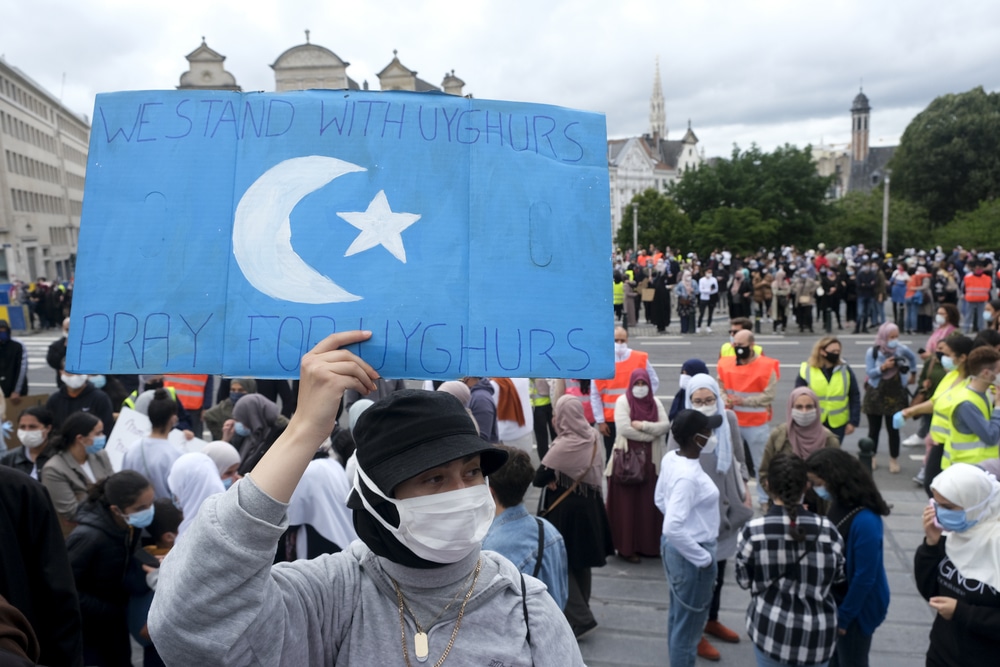In 2019, China was thrust onto the world stage to account for accusations of gross human rights abuses in the far-western province of Xinjiang. A report consisting of hacked documents and compiled by a fanatical Christian sinologist named Adrian Zenz suddenly made it very difficult for Western nations to engage with China, and gave every China hawk in Washington DC, London, and Brussels a singular talking point to dismiss anyone considered to be soft on China. The report supposedly revealed that between “several hundred thousand” to “1.8 million” Uyghur Muslims had been rounded up and sent to concentration camps.
The factual accuracy of that report, and another to follow, have been well-established as fraudulent, but many of the claims, such as an ongoing “Uyghur genocide,” or that there was a tremendous collapse in the birthrate in Xinjiang of over 84%, have stuck around despite their total fabrication.
Now, a new report published as a comment in a Swiss periodical called the New Zurich Paper features a compilation of material from four German researchers and an international law expert who traveled to Xinjiang on a fact-finding mission in May of this year. Their investigation details how the admittedly-oppressive crackdown was not part of an ideological Chinese attempt at manufacturing a holocaust, but rather bog-standard political oppression on those whom a state determined to be dangerous to its existence—in this case, Islamic extremists.
Between 2010 and 2016, frequent terrorist attacks were carried on in Xinjiang by young, fundamentalist Uyghur fighters. One attack in May 2014 saw 37 shoppers killed and 90 injured when cars filled with explosives were crashed into a market, while the following month saw over 100 people killed (including the terrorists) when they stormed government buildings and a police department with knives on July 28. Another knife attack the following year in September killed 50 in a coal mine, leading to Chinese military police forces having to storm a cliff compound with flamethrowers to eliminate the attackers.
China called the attacks “premeditated,” and organized by “domestic and overseas terrorist organizations.” Foreign Minister Wang Yi claimed it was the work of the East Turkestan Islamic Movement (ETIM), which the U.S. State Department and EU listed as a terrorist organization in 2002, and which traveled to Syria to fight alongside ISIS and al-Qaeda affiliates during the civil war against the secular regime of Bashar al-Assad.
Perhaps the key finding in the New Zurich report was that frustrations against Han Chinese immigration into Xinjiang, and restrictions on religious festivals, led to the most extreme factions of separatist Uyghurs to commit violent acts, against which Beijing, like the United States did in the face of 9/11, responded harshly. The U.S. quickly launched two massive invasions of Afghanistan and Iraq while passing the most significant single-scaling back of civil liberties ever seen in the nation’s history. China invaded the region with armies of police and bureaucrats to transform the area as much as possible into one of economic stability, but also potential, in order to disincentivize terrorism, according to the five authors of the report.
The following paragraphs were translated from the New Zurich story using Google Translate, regarding whether the situation in Xinjiang had changed.
According to the local Chinese authorities, the fight against terrorism and Islamism’ in Xinjiang from 2017 to 2020 represented a transitional phase. The new party secretary Ma Xingrui, who has been in office since December 2021, is pursuing the goal of returning to “normality” as quickly as possible. The focus is currently on the institutionalization of law and the return to legal procedures and their expansion.
On the part of the Uyghur population, the modernizations initiated by the central government in terms of education, medical care, and work are clearly met with sympathy. It is reported that the various camps that emerged during the peak phase of the fight against terror have now largely been dismantled. This is also what the critical Xinjiang expert Adrian Zenz, who has presented most of the documentation on developments in Xinjiang in recent years, suggests in a recently published paper.
There are now clear signs of a return to “normality”. In the regions visited by the [authors], police road checkpoints are clearly no longer in use. With the introduction of fifteen years of free education (kindergarten, school, and vocational training) for young Uyghurs, the state has initiated a new development push. In addition, there is state-subsidized health care, initially in the southern part of Xinjiang
The tour group was unable to detect any general discrimination against the Uyghur language and culture, although in Xinjiang, as in all areas of ethnic minorities with their own language and script, standard Chinese is the main language of instruction in schools from secondary school onwards. At compulsory school age, your own language is offered as a subject.
Just as Xinjiang has been the continental “gateway to the West” for China for thousands of years, it will also remain one of the most important corridors for encounters and exchange for Central Asia and, by extension, Europe in the future. If the human rights situation continues to demonstrably normalize, the EU should start dialogue and reconsider the sanctions imposed on China over Xinjiang.
One might think that by relying on government sources and anecdotes from Uyghurs in Xinjiang, this report and its conclusions would be at least as notable and popular in the press as the Adrian Zenz reports of 2019 and 2020; if for no other reason than these are the exact same sources that Zenz and his colleagues at the Jamestown Institute used for their report (the Jamestown Institute used exactly eight Uyghur individuals for their estimates of mass cultural oppression).
However, apart from a South China Morning Post article that posted a translated version with a forward from journalist Alex Lo, and an op-ed written by the two authors of the fact-finding mission, political scientist Thomas Heberer from the University of Duisburg and sinologist Helwig Schmidt-Glintzer from the China Centrum Tübingen, there has been no media coverage with the keywords “Thomas Heberer” and “Xinjiang.”
In the op-ed, the pair acknowledged criticism that they were too close to the Chinese state for their findings to be uncritically examined, but it hardly could have been done independently, since although anyone, foreign journalist or otherwise they write, can visit Xinjiang, facts and figures only recorded by the government or academic institutions that take government money needed to be relied on. However, as they wrote in their report at the New Zurich, Communist Party data was also used for Zenz’ original genocide claims.
“Since the travel time was limited from both sides, we suggested the district of Kashgar in the south (one of the core regions of the Uyghur population) as well as the capital Urumqi, where we mainly sought to speak with legal institutions and academics about issues that the United Nations Human Rights Commissioner had already raised,” write Heberer and Schmidt-Glintzer. “Furthermore, our proposal included the following: The participants will self-funded [sic] the trip; no restrictions on the institutions we propose, the questions we raise, and the places and interlocutors we suggest.”
“We initially assumed that we might encounter a situation like the one that existed until 2021: omnipresent controls, army and police posts everywhere, an oppressive atmosphere. We were stunned that all this no longer existed,” they write.
Genocide is a deeply uprooting activity. The definition includes the purposeful removal of a people from their homeland or from their culture, which by these accounts is far from the truth. Whatever “concentration camps” may have been there were not intended, it seems, to remove anything other than violent separatism.
Zhuoran Li, a research assistant at the School of Advanced International Studies (SAIS) at Johns Hopkins University, wrote in The Diplomat that Beijing still relies on an old communist policy known as the “mass line,” which states that social control of the masses and security needs to be anchored by a visible human presence. However, as Li writes, the mass line tends to be a gentle, even flexible one.
“For example,” Li wrote in July, “one police officer near a famous tourist destination in Beijing said that he had to randomly check people’s ID cards every hour to fulfill the strict quota from ‘above,'” but that after speaking with the officer, “he expressed that he did not want to complete this job; he viewed it as meaningless busywork,” adding “he wanted to help people, not intimidate them”.
“Unlike the rest of the world, subway systems in Chinese cities have security checks, where body scanners use metal detectors to scan all passengers. In addition, every bag must go through an X-ray bag scanning machine,” Li reports from a survey carried out on eight Beijing subway stops. “Security officers in only four of the eight surveyed stations were properly monitoring the bag scanning machine; the rest of them were either chatting with each other or looking at their cell phones rather than the monitor. None of the body scanners in these eight stations carried out their job properly. They barely raised their hands and did not stop any passengers, even when the metal detector beeped”.
Lastly, Li reports, rural policing districts are often made in large cities by people who have never been to the countryside. Rural district managers have the job duty of physically visiting every house, conducting invasive census questioning, and logging it all in a central database. This was viewed by one such official as such a burden, that he “fabricated information without making any visits because he realized that ‘no one would ever use or verify the information.'”
These reports are notably absent from mainstream headlines. This social research was conducted by Li in the central north of China, but based on the account of the rural grid manager, it’s likely to assume that the extremely rural Xinjiang is equally vulnerable to such laxities.
“The fact that there have been changes in Xinjiang with the tendency we have identified has been independently noted by other visitors to the region,” write Heberer and Schmidt-Glintzer. “We are aware that the overall Xinjiang discourse in the Western media cannot be separated from the general policy towards China, which is intensely and controversially debated, especially in the United States,” they succinctly conclude.















